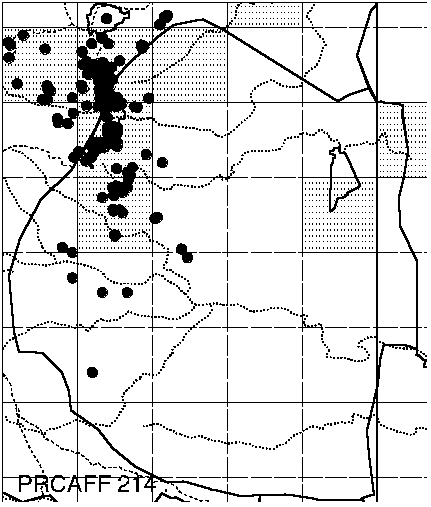
Home
Mission
Overview of Project
Project Staff
Sponsors
Achievements
Checking, Illustrations
Upcoming Activities
Id and Species Lists
Protea Information
Protea Gallery
Growing Proteas
Interim Dist. Maps
Publications
Afrikaanse Inligting
![]()
IDM Swaziland - Common Transvaal Sugarbush - Protea caffra caffra
 A solid black dot indicates where the species is found.
A solid black dot indicates where the species is found.
Protea caffra caffra - Common Transvaal Sugarbush has leaves 13-30 mm wide, with wedge-shaped bases. The flowerheads are 40-70 mm long and petal tubes are 10-14 mm long. It is very variable with many races - recognized by John Beard and sunk by John Rourke - of which the following occurred in the area:
- caffra Highveld Sugarbush (Drakensberg from Royal Natal to Swaziland) with broader (15-25mm) leaves and larger bracts;
- rhodantha var falcata Sickle-leaf Sugarbush (Barberton and Swaziland Escarpment) with the biggest, droopiest leaves, large flowerheads and longer flowers; and,.
- multibracteata Natal Sugarbush (midlands, forelands and southern Drakenberg) [including: baurii, flanaganii, natalensis, pegleriae] with narrower leaves (8-25mm) and smaller bracts.
PR CAFF is the most widespread and common protea in Swaziland. Half of our sites to date have Pr caffra present. But it is very poorly recorded, being regarded as "too common to be of importance". We definitely need more records for this species – please look out for this species! We have good records for the west of Swaziland, although more data from the range extensions to the south of the country need to be obtained. Specifically herbarium records from Mbomwane (2631 CC) should be obtained for the Swaziland Herbarium. The following details are available:
- 2631 CA: KPB 930520 01: 26o38.00’S 31o05.00E 1190m (details withheld by the SNTC) – 1 plant
- 2631 CA: PAW 921208 02: 26o38.00’S 31o10.00’E 1250m (details withheld by the SNTC) – 5 plants
- 2631 CB: KPB 921203 02: 26o31.00’S 31o22.00’E 535m (details withheld by the SNTC) – 7 plants;
- 2631 CC: PAW 921207 04: 26o54.00’S 31o03.00’E 1100m (details withheld by the SNTC) – 5 plants
Does the species not occur between the sites shown?
Despite the many range extensions, we still lack data from some herbarium records. These are for:
- 2531CD Piggs Peak Emlembe (Compton 28493)
- 2632AA Ngwenya Mountains (Compton 835)
- 2631BD Lebombo Mtn 26km S Stegi (Compton 29285)
The latter two records from the Lebombo Mountains suggest that proteas could occur over much of the range in suitable habitat. Could this please be investigated.
Potential Problems
Young Pr caffra plants are very similar to Pr simplex. Although adult Pr caffra are trees, they need to grow large enough to survive fires. Thus young plants form an underground rootstock and produce many stems, which are burned down with every fire, until stems are thick enough to "escape" fires and thus grow up into trees. The moment one branch is thick enough, the other basal branches are shed and the plant assumes its tree-like habit. It thus differs from Pr simplex, which never grows into a tree, and its thin branches usually burn in every fire. The easiest way to distinguish the two species is by the very thin stems in Pr simplex, and the much thicker stems in Pr caffra. The stems in Pr caffra are often branched – seldom so in related species. Pr caffra may stay as a resprouter for decades until fire frequency and intensity allow escape into the tree form. Both differ from Pr parvula with its creeping stems laying flat on the ground.